How to Import & Export Magento 2 Commerce Store Credits

The following article describes the advanced functionality of Magento 2 Commerce – the ability to use store credits without third-party extensions. Below, we explain what Magento 2 store credit is and how to use it. Besides, you will find a guide on how to import and export Magento 2 store credits most efficiently. Let’s define the feature and gradually explore its functionality.

As you might have already heard, store credit is an amount of money that is restored to a customer account and can be used to pay for purchases. As a Magento 2 admin, you can use store credits in several ways. First of all, they represent a perfect replacement for cash refunds. You no longer need to lose money due to various bank commissions and fees – just ad the equivalent store credit amount to a customer’s balance.
After an order is paid and invoiced, you can refund it or its part by issuing a credit memo, which differs from a refund because the balance is restored right in the customer’s account on your e-commerce store. At the same time, you can combine refunds and credits if necessary.
The second example is related to gift cards. Your admin permission allows crediting a balance right to a customer’s account, instead of using a gift card code. It lets you avoid various situations when a customer doesn’t know how to apply his or her gift card code, and you have to explain the whole algorithm in detail.
And you can increase sales and customer loyalty by providing your clients with small credits for free. It can be either a replacement for discounts or a part of a complex marketing strategy.
You can specify the amount of store credit in the configuration section. We explore it below in the workflow section of the article.
Table of contents
Magento 2 Commerce Store Credit Workflow
There are three key aspects related to the Magento 2 Commerce store credit functionality we should draw your attention to:
A customer should be logged into his/her account before going to the checkout page.
The “Use Store Credit” payment option is provided in the Review & Payments step. You can see the available balance, and if it is greater than the order grand total, other payment methods are eliminated automatically.
Next, the amount of store credit is applied to the order being subtracted from the grand total. After the order is placed, Magento adjusts a customer’s available balance.
How to Apply Magento 2 Store Credit
From the perspective of a Magento administrator, you can view both the credit balance and history.

Besides, it is possible to apply a store credit to a purchase; but first of all, it is necessary to view the credit balance:
- Open the Admin sidebar and tap Customers.
- Choose All Customers under Operations.
- Find a customer you are looking for in the grid.
- Proceed to the Action column and click Edit.
- Choose Store Credit in the panel on the left.
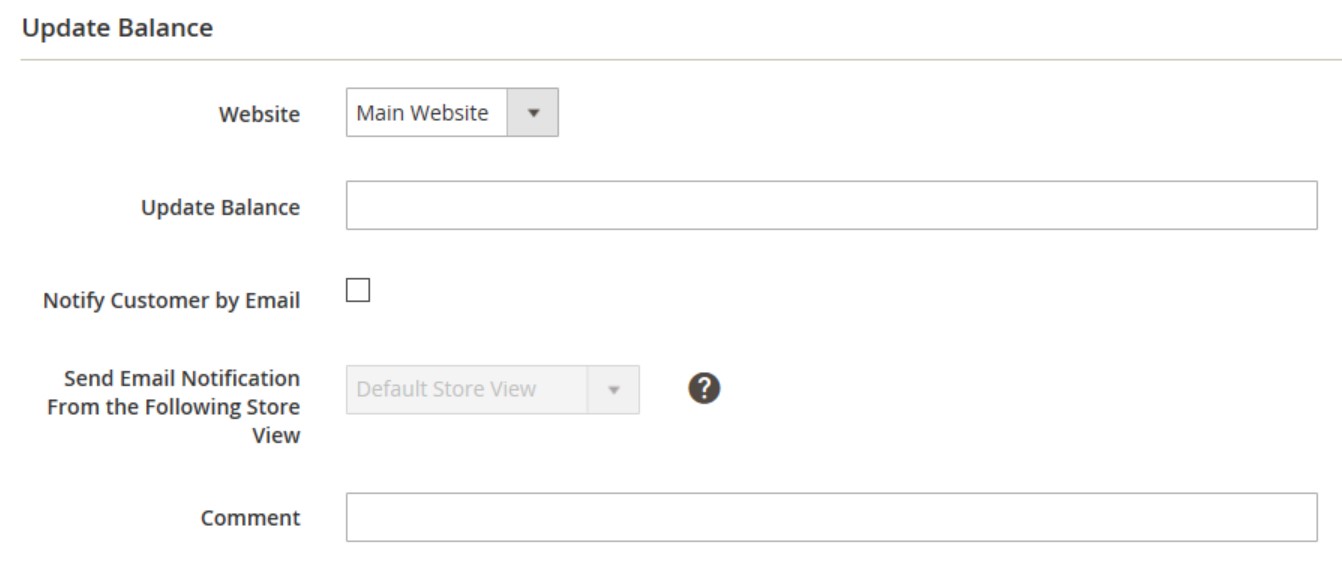
Now, you can configure a store credit. Here, Magento provides the ability to manage automatic refunds, check available credits in a customer account, and set an email template used for notifications.
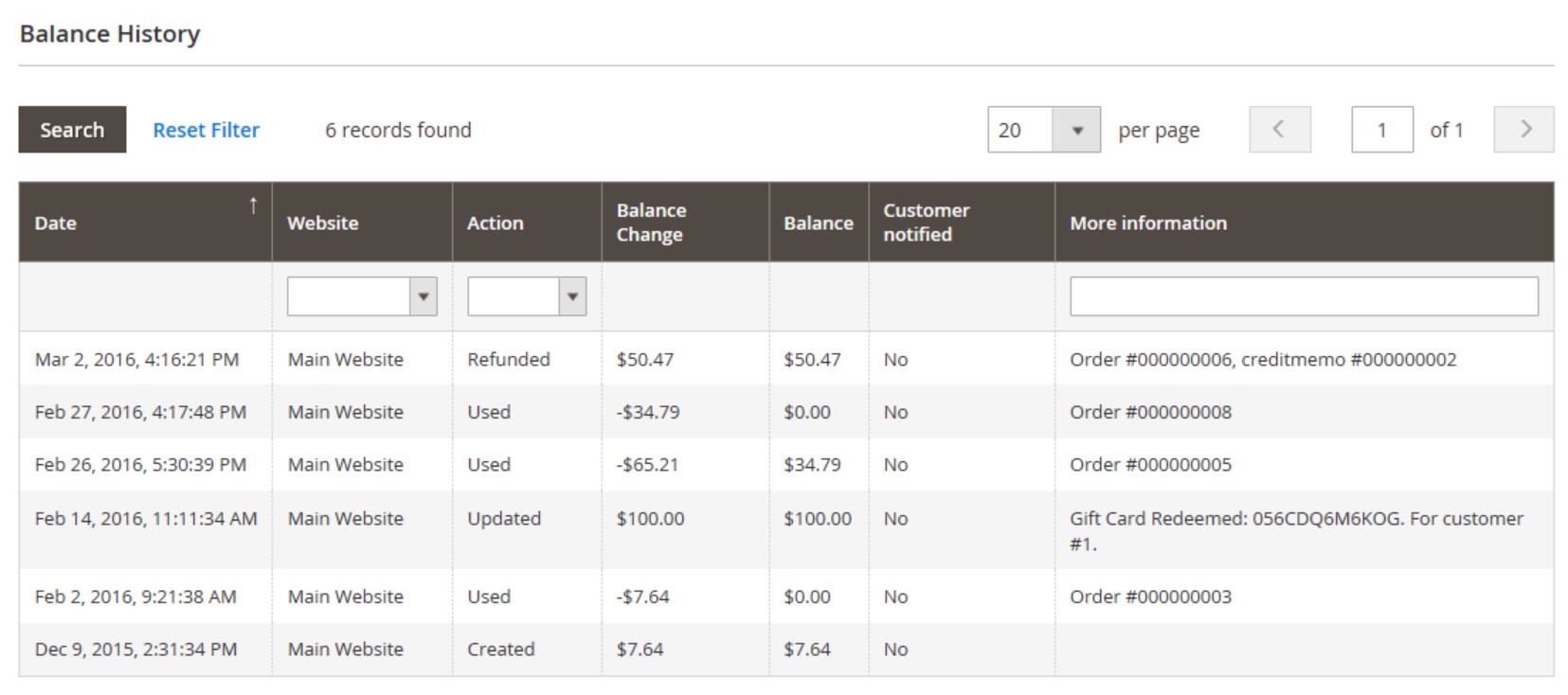
How to Configure Magento 2 Store Credit
As for the configuration section promised above, it is available under Admin -> Stores -> Settings -> Configuration. Go to the left panel and choose Customer Configuration under Customers. There is the Store Credit Options section available there. You should expand the section to do the following:
- Enable/disable the Store Credit Functionality;
- Show/hide Store Credit History from a customer;
- Enable/disable automated Store Credit Refunds;
- Configure an email sender and template.
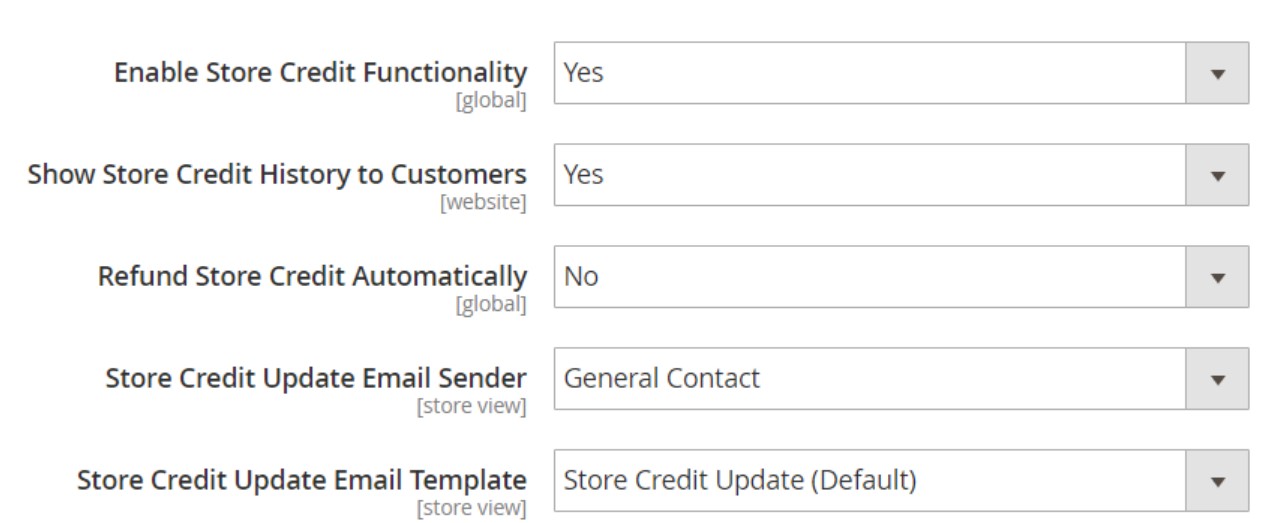
Don’t forget to tap Save Config after all changes are applied.
Magento 2 Commerce Store Credit in Customer Account
As a customer, you can track the status of your refunds and verify the balance of store credit from the accounts dashboard. To view a refund, log into your customer account and see the refunded order in the list of Recent Orders.
Alternatively, you can find it under My Orders tab:
- Click View;
- Tap the Refunds tab;
- Choose Store Credit in the panel on the left.
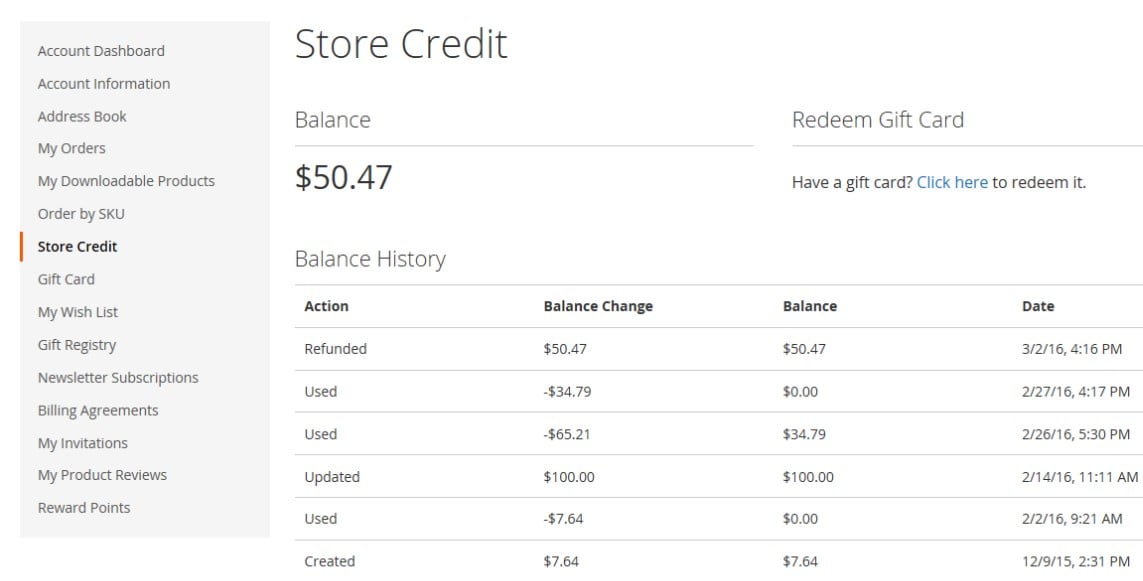
You will see such information as the amount refunded to your store credit as well as date and time of the action.
For further information regarding the Magento 2 Store Credit functionality, follow this link: .
How to Import And Export Magento 2 Store Credit Data

But when it comes to the Magento Store Credit data import and export, Magento cannot satisfy this need. But you can always get the missing functionality with the help of third-party extensions.
Since it is always challenging to find something in a huge ecosystem, especially if it is a reliable import/export extension with multiple features and tools that should be included out of the box, we’ve done the research for you. Unfortunately, the results we not satisfying:
- Most extensions are limited to the import or export process only;
- Integrations are always limited by the number of supported entities;
- Many vital features, such as mapping or automation, are absent.
Not only Magento prevents the Store Credit data import and export, but most third-party tools create barriers to separate you from seamless integrations with external platforms. Such a problematic situation inspired us to create our solution that fixes all the drawbacks providing an enhanced experience.
Meet the Improved Import & Export Magento 2 extension – your number one time-saver when it comes to import and export processes. The module allows moving most Magento 2 entities including Store Credit data. Below, you can see how to do that.
To import Magento 2 Store Credit Data, follow these steps:
- Go to System -> Improved Import / Export -> Import Jobs and hit the Add New Job button.
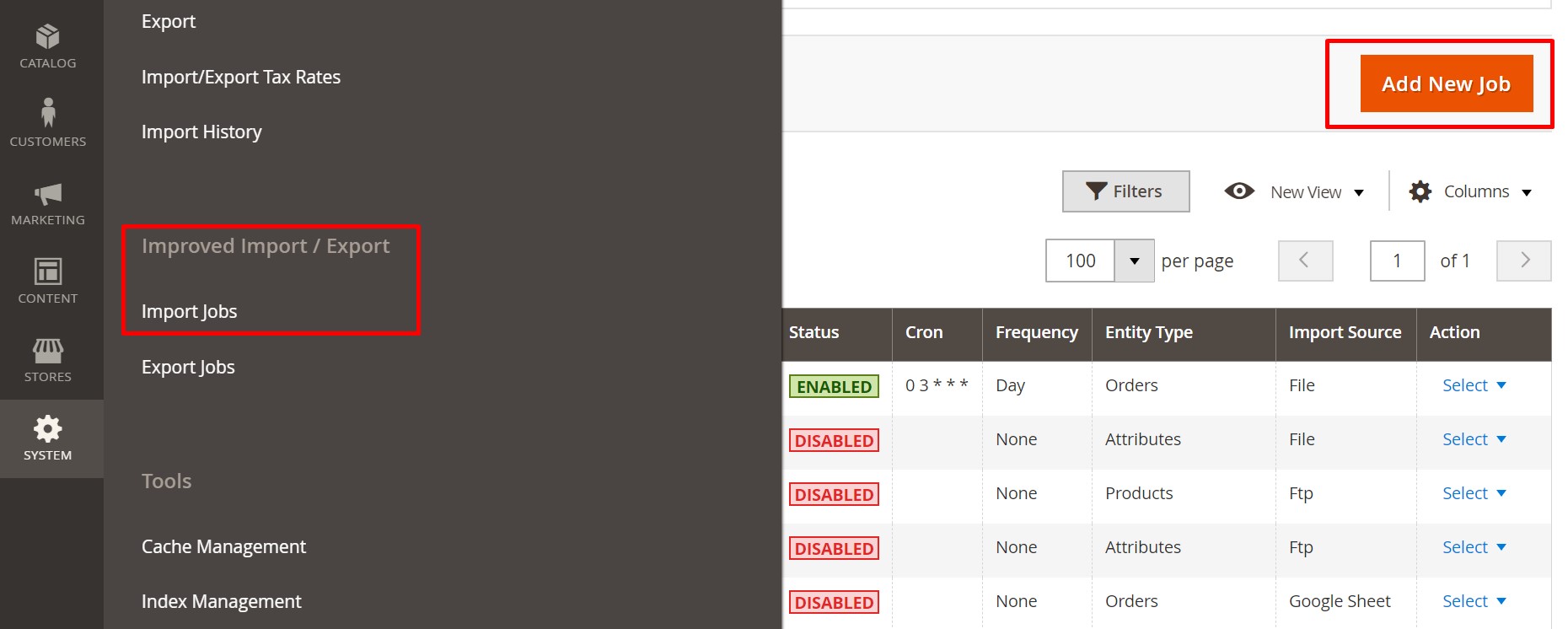
- Configure General Settings and proceed to the Import Settings section. Here, you can select Store Credit Data among options of the Entity drop-down.
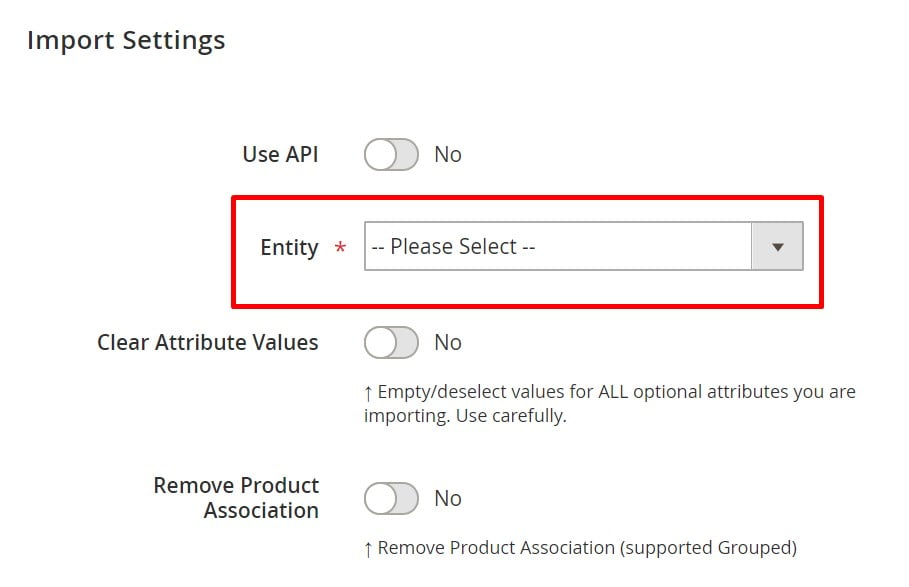
- When the job is configured, save it and run the update.
As for the Magento 2 Store Credit data export, the process is entirely the same. You can configure it under System -> Improved Import / Export -> Export Jobs.
Get Improved Import & Export Magento 2 Extension
Improved Import & Export Magento 2 Extension Features

While Improved Import & Export enables the transfers of Store Credit data, it also enhances multiple other aspects of all import and export processes. Below, we shed light on all its features designed to enhance the way you exchange information between your e-commerce store and external systems.
The module has already become a number one import/export tool for hundreds of merchants worldwide, and you can easily join them. If you have to deal with integrations, data transfers, and synchronizations with external systems, don’t hesitate to give the Improved Import & Export extension a try. Let’s see all privileges the module users get after installing it.
Automated Import & Export Processes
The first benefit we’d like to draw your attention to is the ability to automate all data transfer. Yes, you’ve understood it right: the Improved Import & Export Magento 2 module lets you configure import or export profile only once; next, the plugin will do all the work for you. The ability to automate import and export processes can be achieved in the following two ways: due to schedules or event-based triggers.
Schedules
With the Improved Import & Export Magento 2 extension, you use cron to create fully independent update schedules. Feel free to generate any custom interval or select one of the predefined values which are fully customizable as well.
At the same time, the Improved Import & Export extension provides the ability to simplify transfers of Magento 2 Store Credit data using profiles that have no schedules. They are especially useful if you need to migrate from an external store transferring all the related data. There is no need to create a schedule in this situation.
If some of your integrations are random or asynchronous, the situation is similar so that it’s better to run data transfers manually. Also, note that you can launch every scheduled profile asynchronously whenever you want, so if a partner provides an update file after a scheduled update, you can easily transfer it into your database manually within just a few clicks.
And configuring a schedule is an extremely straightforward procedure. Just take a look at the following gif:

Events
As we’ve just mentioned, there is the second way of automating data transfers. Meet event-based triggers that know no exceptions including Magento 2 Store Credit Data import and export processes. With this alternative method, you get improvements for real-time updates – it is only necessary to specify a proper trigger.
Let’s take a look at a simple example. Let’s assume that it is necessary to transfer order data to an external platform in real time. Create a trigger based on an event when a customer places an order. It will launch an export process that transfers order data to a selected third-party platform. That’s how you enable instant export on the basis of the Improved Import & Export Magento 2 extension.
The same approach can be applied to import processes especially with the support for both system and custom events. After a trigger is defined, specify conditions to make your transfers more precise. For further information, follow this link: How to Run Magento 2 Import or Export After Specific System Event or Process.
Advanced Mapping Features
Now, we’d like to draw your attention to mapping opportunities provided by the Improved Import & Export Magento 2 extension. You won’t probably need this feature transferring Store Credit data from one Magento 2 website to another, but it dramatically improves integrations with all external systems that use different attribute standards. Even when migrating from Magento 1.x to 2.x, you need to use the mapping functionality of our module or do everything manually. Different attribute standards are a huge problem; and below, we shed light on how to solve it.
Mapping Presets
The Improved Import & Export extension provides the ability to reduce the problem with mapping presets designed to match external attributes to the corresponding internal ones in a matter of seconds. You only need to select and apply a preset related to your integration, and the module will do all the work for you.
The Improved Import & Export extension analyzes the input data and then matches all third-party attributes to the internal ones. While dealing with the default editing process, you have to edit data files manually spending tons of time. The procedure should be done every time a new update is provided, or the import process will be interrupted. Presets are applied only once. The one-time action takes a few seconds and consists of several clicks. You can see it below:

Matching Interface
But what if your particular business case cannot be satisfied with a preset? Map attributes manually right in the admin section. The Improved Import & Export Magento 2 extension provides an interface where you can select third-party designation and specify the corresponding internal ones in front of them. It is also a very straightforward routine:

On the image above, you can also see the third column “Default Value.” It is designed to specify hardcoded values provided to all items bound to a corresponding attribute.
For example, you import products from different store views but need to send them to the same one within your e-commerce store. Specify a corresponding store view as a hardcoded value for the “_store” attribute. That’s it.
Attribute Values Mapping
And if you don’t want to transfer third-party attribute values as they are, it is also possible to map them with the help of the Improved Import & Export Magento 2 extension. With our module, you will reduce problems related to external designations even if it is attribute values. Usually, they don’t prevent import processes, but there are some exceptions, so it is a good idea to apply attribute values mapping. Especially since it is always necessary to spend lots of time and effort editing third-party values after the update is already made.
The Improved Import & Export Magento 2 extension offers a user-friendly interface where everything can be efficiently matched. Choose a third-party attribute value and specify the internal one in front of it. The process is similar to attributes matching. Repeat it until no external attribute values are left. For further information, follow this link: Attribute Values Mapping.
Attribute Values Editing
In addition to matching, you can edit attribute values in bulk. The Improved Import & Export module offers the following rules:
- Add a prefix to multiple attribute values;
- Add a suffix to multiple attribute values;
- Split multiple attribute values;
- Merge multiple attribute values.
You can always combine them and create various conditions to increase the efficiency of bulk editing. Follow this link for further information: How to Modify Attribute Values During Import and Export in Magento 2.
Category Mapping
Another mapping feature of the Improved Import & Export Magento 2 extension is related to product categories. While moving products from other e-commerce websites, you may face a situation when all items are bound to categories that are not represented on your e-commerce website. Online stores usually have a unique catalog structure, so you need to edit it before running the import process to organize products in correct order. Since manual editing requires tons of time and effort, we’ve added the corresponding interface to the Improved Import & Export extension which simplifies your routine dramatically. Match external product categories to ones used internally with our extension as shown below:

And you can create new categories on the fly. It is only necessary to select a parent category and specify a new one to add a missing part to your catalog during the import process. Both features are described in this article: Category Mapping.
Attributes On The Fly
If an update file lacks a complete spectrum of data, the import process can be interrupted. But the Improved Import & Export Magento 2 extension lets you avoid errors with the ability to create attributes on the fly. Specify all parameters necessary to generate attributes with the help of the following general form:
Attribute|attribute_property_name:attribute_property_value|…
For further information, read this article: Product attributes import.
Extended Connectivity Options
Extended connectivity options are another vital import/export improvement introduced in our module. With default Magento, you are bound to lots of limitations regarding data transfers. The platform offers only one way to synchronize data between your e-commerce store and external systems – via CSV files.
As for the Improved Import & Export extension, it not only offers several more ways of creating a bridge between your e-commerce store and third-party platforms but also provides an extended range of supported file formats.
Multiple File Standards
As we’ve just mentioned, Magento is bound to CSV files only, which is sometimes enough but most business cases require more formats. As for the Improved Import & Export Magento 2 extension, it essentially increases the number of supported standards. With our module, you can run data transfers using XML, JSON, ODS, and Excel files applying all the module’s features, such as mapping of attributes and values, scheduling, attributes on the fly, etc.
Multiple File Sources
To increase the flexibility of data transfers, the Improved Import & Export Magento 2 extension provides the ability to multiple file sources. The module offers the following connection options:
- FTP/SFTP. You can transfer files using your local server. A remote one can also be utilized.
- Dropbox. A Dropbox account can be used instead if necessary.
- URL. For import processes only, it is enough to specify a file URL.
And if a new update is provided in a compressed state, there is no need to extract it as in case of the default import tool. The Improved Import & Export Magento 2 extension will do that for you.

Alternative Ways of Import & Export
As mentioned above, the Improved Import & Export Magento 2 extension offers several alternative ways of import and export. Thus, you can exchange data not only with the help of files but also using API integrations and intermediary services.
With our module, you can connect your e-commerce store to an external system directly via REST, SOAP, and GraphQL APIs. Like in case of additional file standards, API connections work well with mapping, scheduling, and other extension features!
Now, let’s say a few words about intermediary services. As you might have already guessed, they are represented by various online sheets. The Improved Import & Export Magento 2 extension lets you use Google Sheets, Office 365 Excel, or Zoho Sheet to exchange data between your website and external platforms. The integration on the basis of Google Sheets looks as follows:

Watch the following video to see the extension in action:
Final Words
If you are a Magento 2 Commerce user, it is no longer necessary to install third-party store credit extensions since the platform provides the corresponding functionality out of the box. But you still cannot import/export the appropriate data with the default Magento tools. Luckily, the Improved Import & Export extension easily enables the necessary functionality. Need to import and export Magento 2 store credit data? You’ve come to the right place. Follow the link below to get the extension. Contact our support for further information.
Get Improved Import & Export Magento 2 Extension
Not sure how to import specific data types into Magento 2? Our guide covers everything — from products and customers to CMS pages and B2B entities.
👉 Browse all Magento 2 import topics

